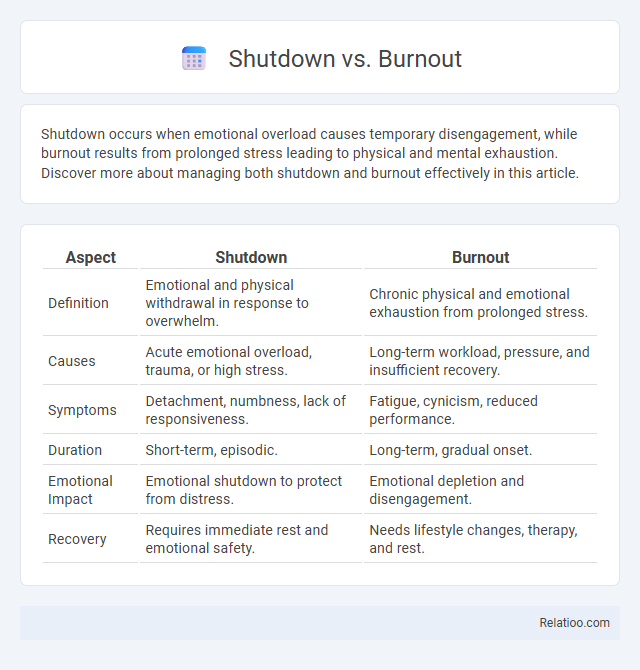Shutdown occurs when emotional overload causes temporary disengagement, while burnout results from prolonged stress leading to physical and mental exhaustion. Discover more about managing both shutdown and burnout effectively in this article.
Table of Comparison
| Aspect | Shutdown | Burnout |
|---|---|---|
| Definition | Emotional and physical withdrawal in response to overwhelm. | Chronic physical and emotional exhaustion from prolonged stress. |
| Causes | Acute emotional overload, trauma, or high stress. | Long-term workload, pressure, and insufficient recovery. |
| Symptoms | Detachment, numbness, lack of responsiveness. | Fatigue, cynicism, reduced performance. |
| Duration | Short-term, episodic. | Long-term, gradual onset. |
| Emotional Impact | Emotional shutdown to protect from distress. | Emotional depletion and disengagement. |
| Recovery | Requires immediate rest and emotional safety. | Needs lifestyle changes, therapy, and rest. |
Understanding Shutdown and Burnout: Key Differences
Shutdown involves a complete withdrawal from activity or interaction, often as a response to overwhelming stress or sensory overload, while burnout manifests as chronic physical and emotional exhaustion linked to prolonged work-related stress. Understanding the key differences includes recognizing that shutdown is a sudden, temporary state requiring immediate rest, whereas burnout develops gradually, marked by decreased motivation and productivity over time. Effective management strategies differ: shutdown calls for immediate sensory relief and supportive environments, while burnout necessitates long-term lifestyle adjustments and professional intervention.
Causes of Shutdown vs. Burnout
Shutdown often results from overwhelming stress or trauma that triggers dissociation and emotional numbness, while burnout stems from prolonged workplace stress, leading to exhaustion, cynicism, and reduced performance. Your brain may initiate shutdown as a protective response to acute emotional distress, whereas burnout develops gradually due to chronic pressure and lack of recovery. Understanding the distinct causes helps in targeting appropriate interventions for mental health and wellbeing.
Early Warning Signs: Shutdown vs. Burnout
Early warning signs of shutdown include withdrawal, reduced communication, and emotional numbness, often indicating mental overload and the body's need to conserve energy. Burnout manifests through chronic fatigue, irritability, and decreased performance, signaling prolonged stress and exhaustion in professional or personal life. Recognizing these distinct symptoms helps differentiate between immediate emotional shutdown and ongoing burnout, facilitating timely intervention and support.
Emotional and Physical Symptoms
Shutdown involves emotional numbness and physical immobility often triggered by overwhelming stress, while burnout manifests through chronic exhaustion, irritability, and decreased cognitive function due to prolonged work-related strain. Emotional symptoms of shutdown include feeling disconnected and unresponsive, contrasting with burnout's persistent feelings of frustration and hopelessness. Your awareness of these distinct emotional and physical symptoms can guide more effective coping strategies and interventions.
Impact on Work Performance
Shutdown causes a sudden halt in work productivity due to overwhelming stress, leading to reduced focus and inability to complete tasks. Burnout results from chronic workplace stress, causing exhaustion, cynicism, and decreased efficiency over time. Shutdown, as a mental state, severely impairs decision-making and creativity, further diminishing overall work performance.
Psychological Effects and Wellbeing
Shutdown, burnout, and shutdown represent distinct psychological states with unique effects on wellbeing. Shutdown involves a temporary psychological retreat often linked to trauma, resulting in emotional numbness and reduced cognitive function. Burnout signifies chronic workplace stress causing exhaustion, cynicism, and decreased professional efficacy, severely impairing mental health and overall quality of life.
Coping Mechanisms and Recovery
Shutdown often requires grounding techniques like deep breathing and sensory regulation to manage sensory overload, while burnout recovery focuses on rest, boundary-setting, and stress management to restore energy and motivation. Coping mechanisms for shutdown include creating a calming environment and paced exposure to triggers, whereas burnout demands long-term lifestyle changes such as workload adjustments and prioritizing self-care routines. Effective recovery involves recognizing early signs, seeking professional support when necessary, and implementing strategies tailored to the specific needs of shutdown or burnout conditions.
Prevention Strategies for Shutdown and Burnout
Preventing shutdown and burnout requires prioritizing regular self-care practices such as adequate sleep, balanced nutrition, and consistent physical activity to maintain mental and physical resilience. You should establish clear boundaries between work and personal life, incorporating scheduled breaks and stress management techniques like mindfulness or therapy to reduce overload. Early recognition of symptoms and seeking professional support can mitigate the progression of both shutdown and burnout, ensuring sustainable productivity and well-being.
Seeking Help: When and Where
Seeking help for shutdown, burnout, and collapse is crucial when prolonged stress impairs daily functioning and emotional well-being. Resources include mental health professionals, such as psychologists or counselors specializing in stress management, and support groups tailored to specific conditions. Early intervention through workplace support programs or community mental health services enhances recovery outcomes and prevents escalation.
Long-term Consequences and Resilience
Shutdown, burnout, and overwhelm have distinct long-term consequences that impact your mental health and productivity differently. Burnout often leads to chronic exhaustion, decreased motivation, and impaired cognitive function, while shutdown results in emotional numbness and withdrawal, making recovery challenging without proper support. Building resilience through consistent self-care, stress management, and seeking professional help can mitigate these effects and strengthen your ability to cope with future stressors.

Infographic: Shutdown vs Burnout
 relatioo.com
relatioo.com